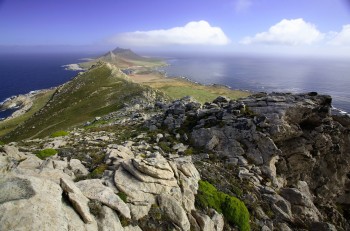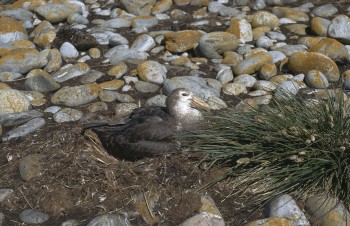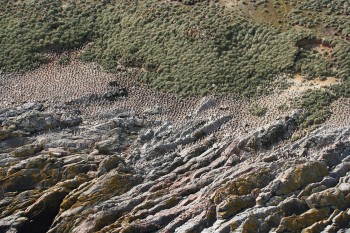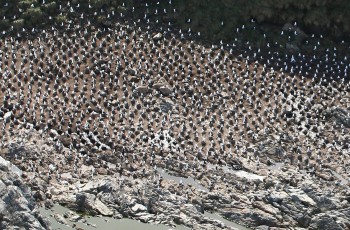At 790 ha and eight kilometres in length, Steeple Jason is the second largest island in the Jason Islands Group. The group forms part of the Falkland Islands (Islas Malvinas)*, and lies north-west of West Falkland. The island has a rocky ridge rising to 290 m that is divided into two sections by a narrow neck. Tussac (Tussock) Grass Poa flabellata is the predominant vegetation.

Steeple Jason Island looking west from East End Peak
The uninhabited island has been a private nature reserve since 1970. It is now owned (along with neighbouring Grand Jason) by the Wildlife Conservation Society of New York, a US-registered conservation organisation, and falls within the Jason Islands Group Important Bird Area. Previously the island was run as sheep and cattle farm: none now remain and the island’s overgrazed vegetation is recovering. However, a population of introduced House Mice Mus musculus is still present. Day visits by tourists from cruise ships are allowed, but only researchers stay for longer periods, utilizing a research station constructed in 2003. In 2002 a fire caused by a lightning strike was contained to a small area. A management plan for Steeple and Grand Jason was being developed in 2006.
Two ACAP-listed species breed on Steeple Jason: the Black-browed Albatross Thalassarche melanophris and the Southern Giant Petrel Macronectes giganteus.
An aerial photographic survey on Black-browed Albatrosses in 2010 yielded a total of 183 135 occupied nests, making this the largest colony of the species in the Falkland Islands (Islas Malvinas)*. It has been reported that in December 2010 a severe storm caused a roughly estimated 15–30% of the Black-browed Albatross nests on Steeple Jason to suffer breeding failure, considered equivalent to a minimum of about 18 200 nests (click here). Recent research has shown the species is on an upward trend in the Falkland Islands (Islas Malvinas)*.
Some 1500-2000 pairs of Southern Giant Petrels breed annually in the Jason Islands Group. Steeple Jason, along with Grand Jason, supports most of these birds. There were 1051 occupied nests on Steeple Jason in November 2000 and 1440 in December 2004.

A Southern Giant Petrel breeds on Steeple Jason

Aerial view of Steeple Jason taken at the west end of the island looking east over a main section of the island’s Black-browed Albatross colony. The Tussac Grass fringe is slowly being encroached by the expanding colony

Aerial photograph of a section of the Black-browed Albatross colony taken at 400 feet (120 m) with a high-resolution camera allowing an accurate count, as well as information on colony expansion


Main albatross colony with well-advanced chicks viewed from North-west Point
Photographs by Ian Strange
Selected References:
Catry, P., Forcada, J. & Almeida, A. 2011. Demographic parameters of Black-browed Albatrosses Thalassarche melanophris from the Falkland Islands. Polar Biology 34: 1221-1229.
Chater, T. 2005. Steeple Jason. In: Summers. D. A Visitor’s Guide to the Falkland Islands. The Essential Guide for any Visitor to the Falkland Islands. Second Edition. London: Falklands Conservation. pp. 102-105.
Crofts, S., Wolfaardt, A. & Baylis, A. 2011. Storm damage to colonial seabirds at Beauchêne Island and Steeple Jason Island during 13-14 December 2010. 20 pp.
[Falklands Conservation] 2006. Important Bird Areas of the Falkland Islands. London: Falklands Conservation. 160 pp.
Reid, T.A. & Huin, N. 2008. Census of the Southern Giant Petrel population of the Falkland Islands 2004/2005. Bird Conservation International 18: 118-128.
Strange, I.J. 2008. Aerial Surveys of Black-browed Albatross Thalassarche melanophris: the Methodology Employed and Comparisons with Surveys Carried out in 1986-2005-2006 and 2007. New Island: Design in Nature & Falkland Islands Wildlife. 59 pp.
Strange, I.J. & Strange, G. 2011. Black-browed Albatross Thalassarche melanophris. Aerial Photographic Survey Methodology: Advantages over Ground Surveying in the Falkland Islands. Results and Comparisons with Surveys in 2005 and 2010. Stanley: Design in Nature. 30 pp.
Thompson, K.R. & Rothery, P. 1991. A census of the black-browed albatross Diomedea melanophrys population on Steeple Jason Island, Falkland Islands. Biological Conservation 56: 39-48.
Wheeler, T. 2004. The Falklands & South Georgia Island. Footscray: Lonely Planet Publications. 200 pp.
Wolfaardt, A.[C.] 2012. An Assessment of the Population Trends and Conservation Status of Black-browed Albatrosses in the Falkland Islands. 23 pp.
Wolfaardt, A.C., Crofts, S., & Baylis, A.M.M. 2012. Effects of a storm on colonies of seabirds breeding at the Falkland Islands. Marine Ornithology 40: 129-133.
Wolfaardt, A.C., Rendell, N. & Brickle, P. 2010. Falkland Islands Implementation Plan for the Agreement on the Conservation of Albatrosses and Petrels (ACAP): Review of Current Work and a Prioritised Work Programme for the Future. Stanley: Falkland Islands Government. 57 pp.
Ian Strange, New Island Conservation Trust, New Island, Falkland Islands (Islas Malvinas)* & John Cooper, ACAP Information Officer, 27 August 2013
*A dispute exists between the Governments of Argentina and the United Kingdom of Great Britain and Northern Ireland concerning sovereignty over the Falkland Islands (Islas Malvinas), South Georgia and the South Sandwich Islands (Islas Georgias del Sur y Islas Sandwich del Sur) and the surrounding maritime areas.

 English
English  Français
Français  Español
Español